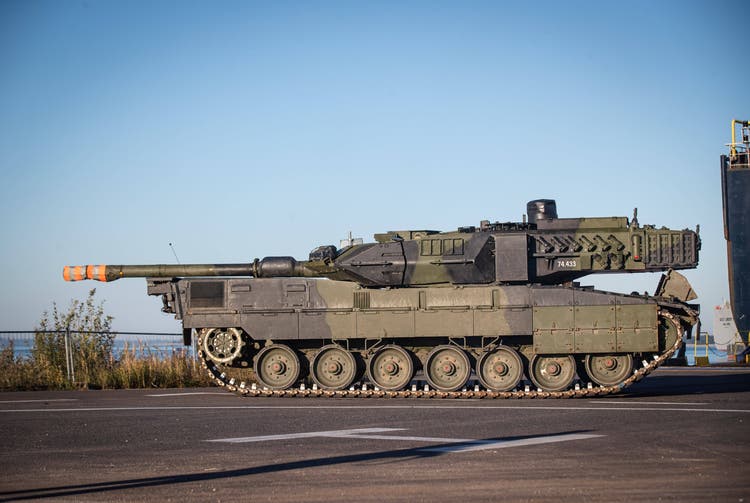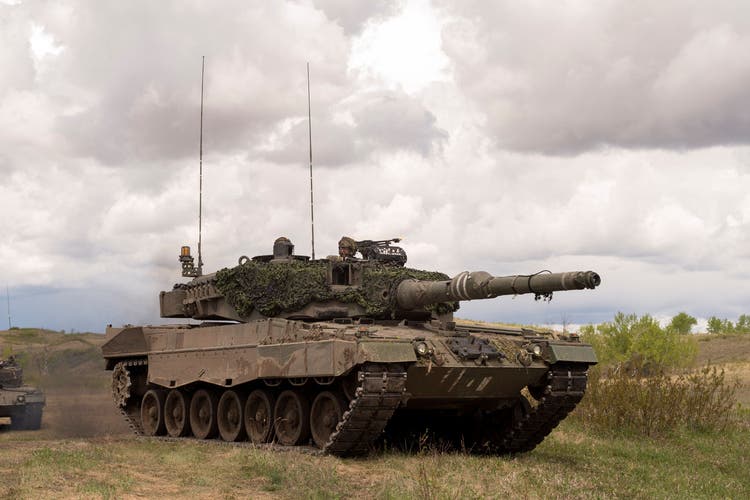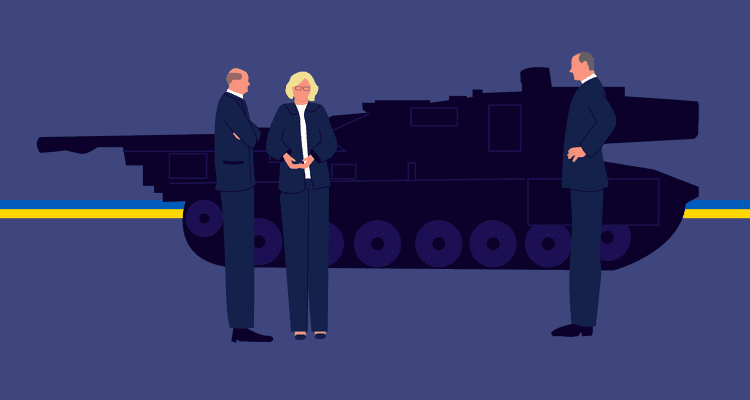France wants to deliver reconnaissance tanks, but that won’t be enough for Ukraine. The country needs battle tanks and armored personnel carriers. Pressure is mounting on Chancellor Olaf Scholz to give up his hesitant stance on supplying Leopard 2 tanks.
Germany is still reluctant to supply tanks to the Ukraine – after the French initiative, it is questionable how long the resistance will last.
France got out of cover. The Élysée announced yesterday that it wanted to deliver “light battle tanks” of the AMX 10 RC type to Ukraine. Since then, the debate in Germany about the supply of battle tanks has been ramping up again. Strategic direction: The position of German Chancellor Olaf Scholz that there will be no going it alone when it comes to supplying tanks can no longer be maintained.
But the Paris offer has nothing to do with what Ukraine wants from Germany. The AMX 10 RC is a six-wheeled armored vehicle with a gun to scout enemy positions, weighs 14 tons and is poorly protected. A reconnaissance tank that looks briefly and then gives way to those heavy weapons that Kyiv would much rather have than AMX 10 RC: the main battle tanks.
No battle tanks for fear of nuclear escalation
A 65-ton monster made of steel, traveling at 70 km/h, with a smoothbore gun that hits its target at full speed from a distance of 3,000 meters – that is the Leopard 2, Germany’s weapon that could give Ukraine a decisive advantage. The main battle tank is a state-of-the-art offensive weapon, its basic structure today hardly differs from that of the tanks in World War II. It still consists of a self-supporting hull and pivoting turret, is still tracked and carries a cannon.
The Leopard 2A7, the most modern version of the German Bundeswehr, is now a computer-aided vehicle, fast, mobile and assertive, and incomparably more heavily protected than all its predecessors. His deployment in Ukraine would bring a quicker end to the Russian invasion. This is how the CDU chairman Friedrich Merz and the chairwoman of the defense committee in the Bundestag, Marie-Agnes Strack-Zimmermann (FDP), see it.

The Leopard 2A7 main battle tank.
But Chancellor Scholz and his Social Democratic Defense Minister Christine Lambrecht have so far slowed down. Behind the two positions are two different strategic considerations. Some assume that modern battle tanks will enable the Ukrainian armed forces to conduct a decisive operation and thus shorten the war. The others have wanted to avoid this so far because they fear that Putin will reach the point where he will escalate the war with nuclear weapons.
Gulf War: Destruction of Soviet tanks
In recent war history there is an event that showed the superiority of Western main battle tanks over Russian ones. In the 1990/91 Gulf War over Kuwait, the American Abrams destroyed hundreds of Soviet-made Iraqi tanks. It was an uneven fight: The US tanks had computerized fire control systems with high-resolution cameras and thermal imaging devices. The soldiers saw the enemy before he could see them.
Its turret is similar to that of the Leopard 2 tank. The cannon fired accurately even when the Abrams was traveling at high speed over rough terrain, while the Iraqis had to stop their Soviet T-54s and T-62s to get a accurate shot. They hardly got to that because the American ammunition had a much longer range. Before the Iraqi crews could fire, they were dead.
Shot-up Russian tanks, cheering American soldiers – it’s these pictures from Kuwait that Ukrainian politicians in Berlin are using to advertise German Leopard 2s. Tanks, such as those used in large numbers by the Russian army today, T-62, T-64, T-72, have no chance in a duel with modern Western weapon systems. But the Kuwaiti desert is not the Donbass with its cities, villages and industrial plants, with its forests and covered terrain. Tanks fight best at a distance of three or four kilometers, in towns they are easy prey for infantry.
The Russians have lost between 1,000 and 2,000 main battle tanks in Ukraine since February, most of them to anti-tank weapons and artillery. For tank specialist Wolfgang Schneider, a colonel out of service with the Bundeswehr, modern versions of the Leopard 2 would therefore not have the operational effect that the Ukrainians were hoping for. “Especially at the focal points of the front in the south and southeast with intersected terrain and many towns, rivers and industrial areas, the Leopard 2 could not bring its advantages to bear,” he says.
Battle tanks would help liberate Ukraine
The question is whether this is the crucial point for the Ukrainians. At the end of last year, army chief Valeri Saluschni said that in addition to artillery pieces, he needed 300 main battle tanks and 600 infantry fighting vehicles as soon as possible, but not outdated Russian models, but modern Western ones. Because the Ukrainians are no longer concerned with repelling Russian attacks, but with the liberation of occupied areas in the Donbass. Western military experts suspect that the push will be south toward Melitopol or Kremina to encircle and crush the Russian troops massed there and force Putin to negotiate.
The tanks would therefore not operate in places where they would be easy targets, as argued by opponents of tank deliveries in Germany. Rather, they would be needed to form a buffer, to penetrate and encircle the Russian positions. That would correspond to the tank tactics trained in the German Bundeswehr. The faster these tanks drive, the better they are protected, the more effective their weapons are, the higher the chances of success.
300 main battle tanks – that sounds like a lot. But in NATO there are several thousand modern battle tanks of various types and countless explanations as to why delivery to Ukraine has not been possible so far. Germany, for example, had just over 2,200 Leopard 2 tanks when the Wall fell. 33 years later there are barely 150 operational tanks in the yard. The Ministry of Defense keeps their exact number secret. By 2027, the German army should be equipped with 328 battle tanks of various types, ultra-modern, superior to any Russian tank today. Defense Minister Lambrecht says not a single Leopard 2 is left for Ukraine because otherwise the Bundeswehr would not be able to rebuild its defense capabilities and fulfill its NATO commitments.
What is Germany waiting for? The war is now
But against whom did Germany want to defend itself with main battle tanks in a few years if the conventional Russian army in the Ukraine was soon to be permanently weakened using Leopard 2? The war, for which Germany wants to be prepared in a few years, is taking place now, the Ukrainians are running out of time.
This is what advocates of immediate Leopard 2 deliveries are arguing. The tanks, they say, don’t have to come from Germany alone. Rather, the federal government must give up its blockade so that other countries with Leopard tanks can also send them to Ukraine. The German arms export regulations stipulate that any transfer of Leopard 2 tanks must be approved by the government in Berlin. So far, the chancellor has not indicated that he intends to move away from this position.
There is no shortage of Leopard 2 tanks. In the 16 NATO and EU countries equipped with Leopard 2, there are more than 2000 tanks combined. But so far only Spain has offered 100 Leopard 2A4s for Ukraine, but withdrew the proposal because the vehicles were outdated and hardly operational. Earlier this week, MPs in Helsinki said the Finnish army had 100 Leopard 2A4s left over to deliver to Ukraine. In the spring of 2022, Armin Papperger, head of the German armaments group Rheinmetall, offered to make 80 Leopard 2A4s from their own stocks operational for Ukraine. The federal government did not respond to this.
The Leopard 2A4 dates from the 1980s. It has partially significantly weaker armor than today’s versions, has an outdated fire control system and a shorter gun. To put it simply: he is more vulnerable, shoots more slowly and has to get closer to the target. In addition, there are currently only a few 120-millimeter ammunition in all NATO countries except the USA.

The Leopard 2A4 photographed in Canada in 2017.
But even those could currently only help with old stocks. To do this, the fire control computers of the tanks would have to be adapted to the US ammunition. All this lasts and does not bring any short-term benefit to the Ukrainian armed forces. What they need are ready-to-use modern tanks with the highest possible level of protection against anti-tank weapons, high-resolution optics and cameras, a superior and accurate gun, and ease of use.
Crew training within eight weeks
Leopard versions 2A5 to 7, of which there are hundreds in NATO, for example in Norway, Denmark, Greece, Turkey, Spain, Canada and Germany, offer all of this. Opponents of tank deliveries have argued in the past that it is not possible to teach the Ukrainians how to use the tank in a crash course. But that’s not true. The Leopard 2 was conceived when the German Bundeswehr was still a conscript army. The soldiers basically had to be able to operate the tank within a few weeks. Experts say the Ukrainian soldiers could be trained in six to eight weeks.
Another argument against tank deliveries is that the vehicles could not be repaired due to a lack of technicians and spare parts. It is impossible to bring every defective tank to Poland or Slovakia for repair, as is the case with the Panzerhaubitze 2000. Supporters of the deliveries reply that every major NATO exercise used to involve training how to repair a tank during an ongoing operation. In other words: What the conscripts managed in Germany, the experienced Ukrainian soldier also brings.
Armaments policy: Germany without strategic foresight
And then there is another point of contention. It is taking too long for modern tanks delivered to Ukraine to be replaced in western armies. That’s what some say and open an account. Norway has just tendered for the delivery of 80 main battle tanks. Should Kraus-Maffei Wegmann win the bidding competition and Norway place an order by the end of January, time-consuming negotiations will begin with the suppliers: Renk gearboxes, MTU engines, Diehl armored tracks, Rheinmetall cannons, SSAB armored steel. All in all, it will take two years, the assembly of the tanks will start at the end of 2024 at the earliest and will last until the beginning of 2027. In that time, not a single Leopard could be built for another country.
The others say that in the 1970s there were three tank factories in Germany. If the political will and money are there, the industry is also able to expand capacities. But this required a government that made armaments policy a top priority. Instead, the credo of the Berlin Ministry of Defense still applies to tank construction: We order vehicles, we don’t make strategic industrial policy.
